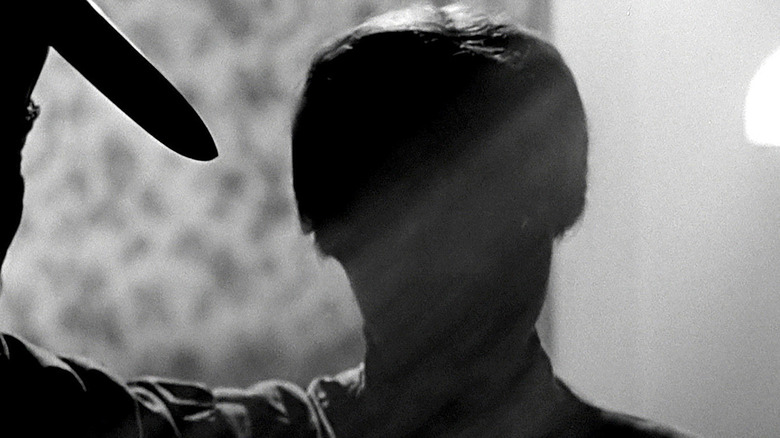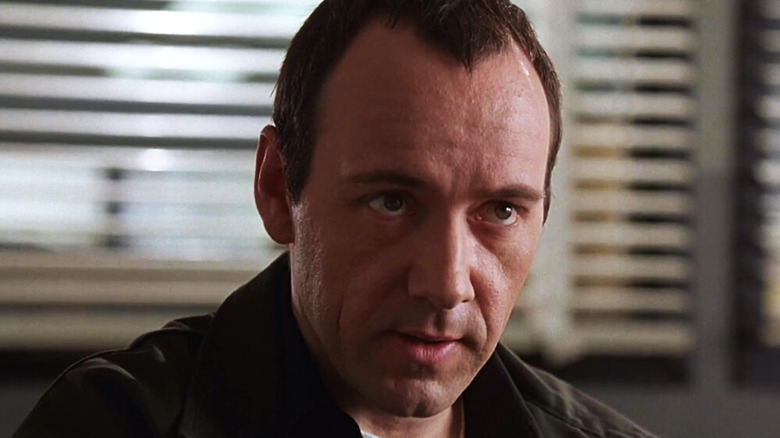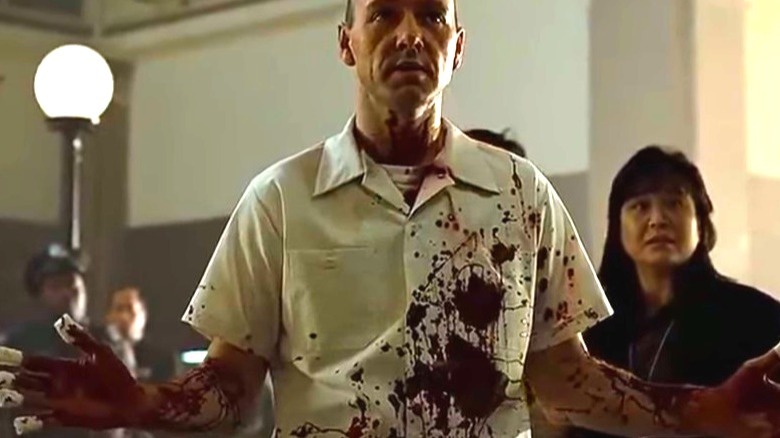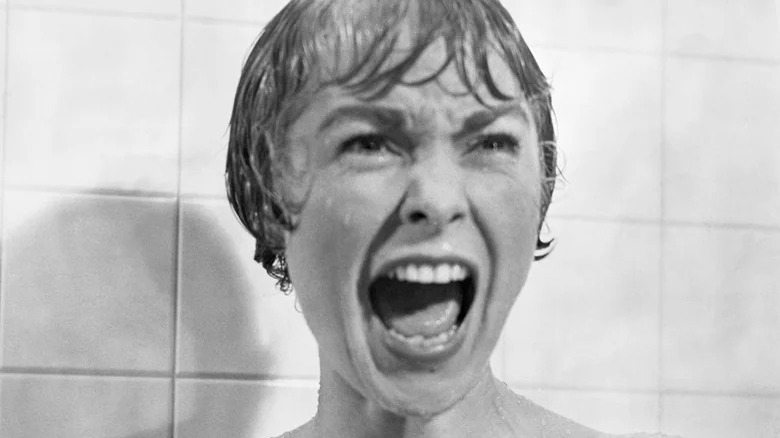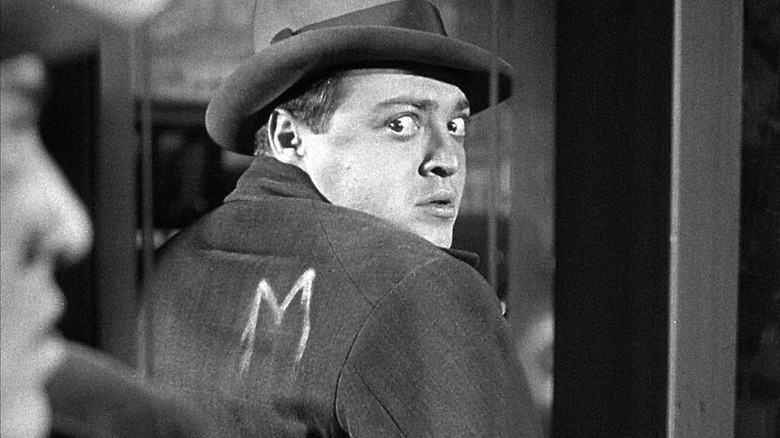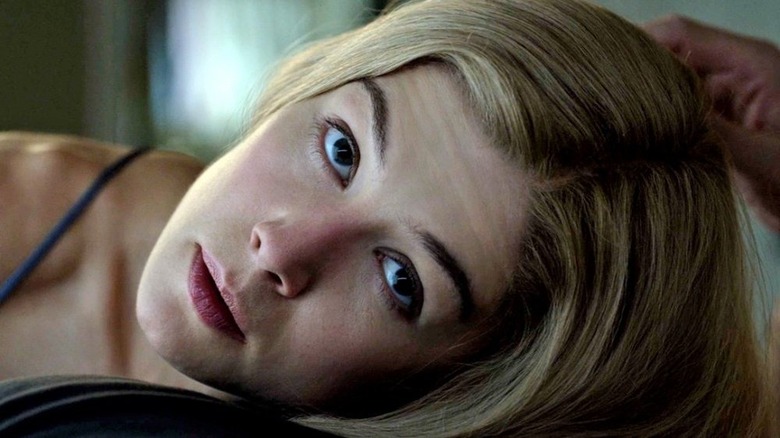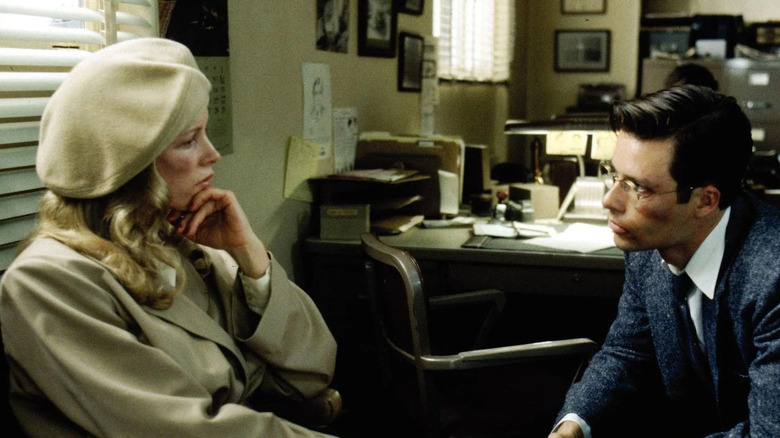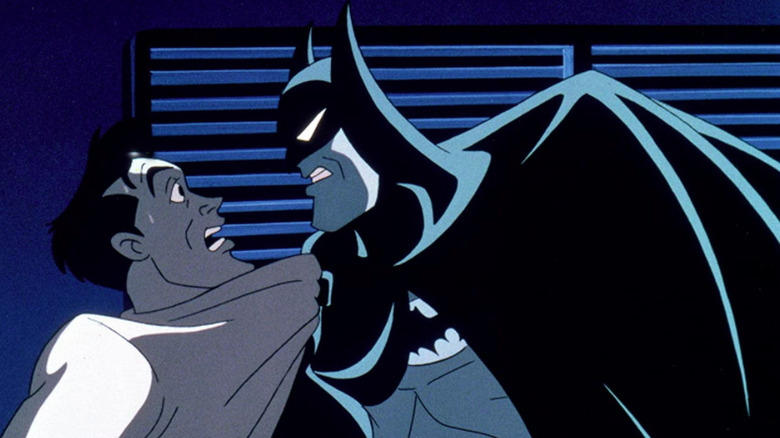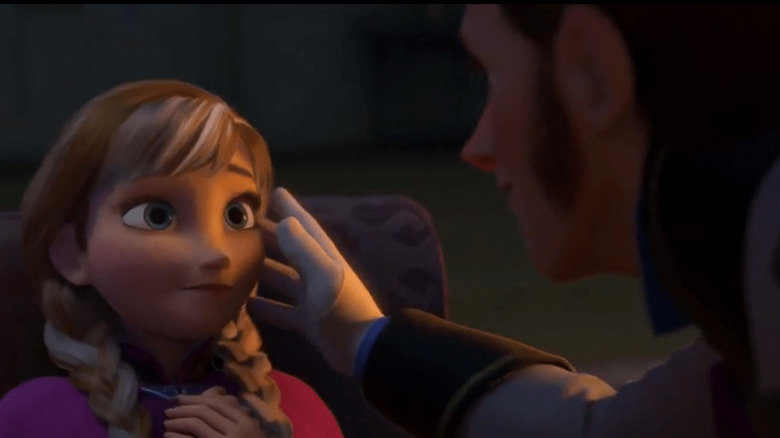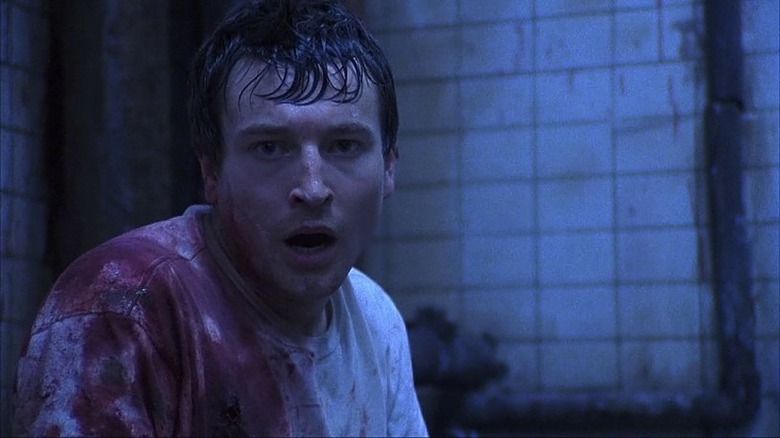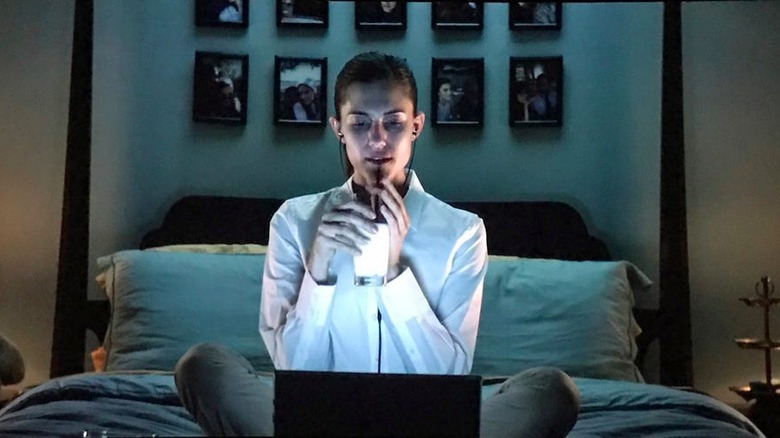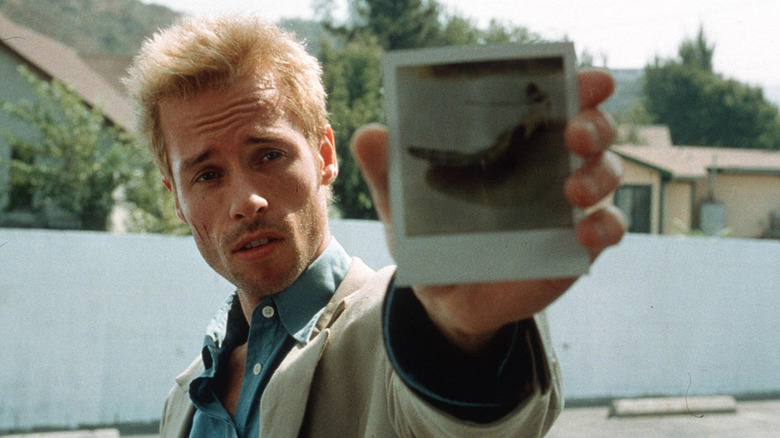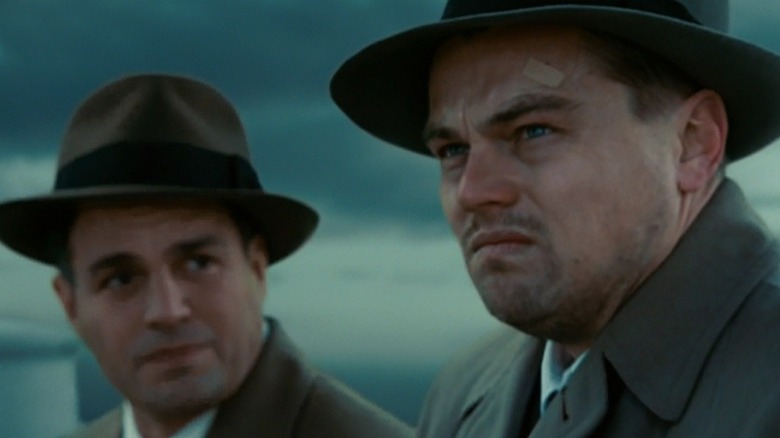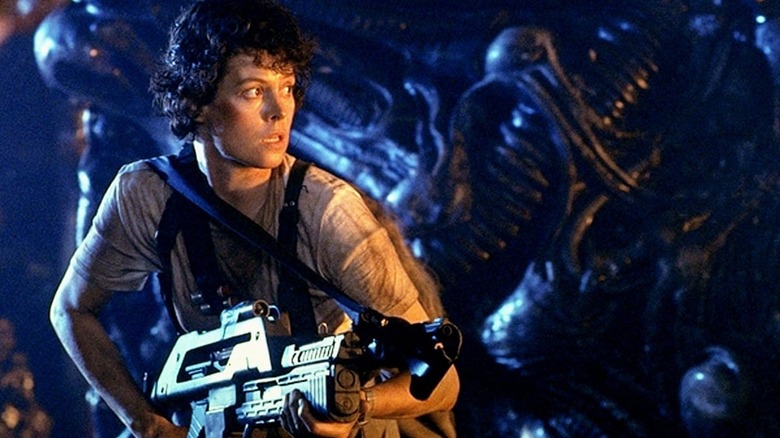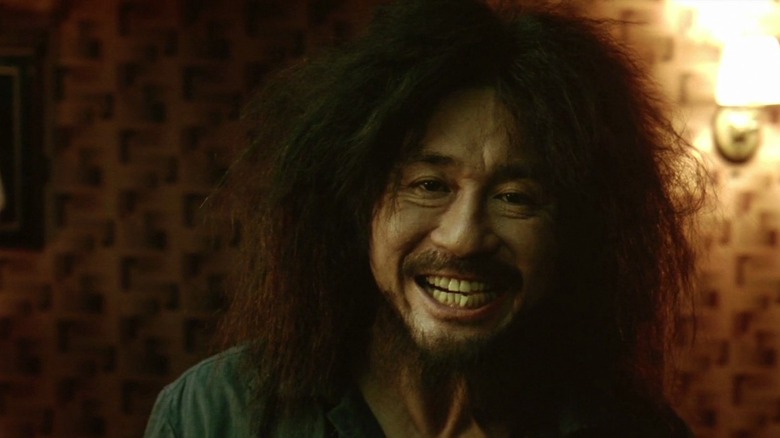The Best Bad Guy Reveals In Movie History
To a lot of fans, the villain is the best part of a great movie. Some films place their villains front and center, like 2008's "The Dark Knight" does with its infamous antagonist, the Joker. Introducing the villain before the film's protagonist is a great way to not only immediately hook an audience but also elicit instant sympathy for the story's hero.
Other movies, however, like the ones on this list, save their villains' unveiling for later in the film or even all the way at the conclusion. These slow builds allow the impressions of a villain to marinate, so they arrive on screen fully flavored by audience expectation. When done well, the villain reveal is one of the most satisfying rewards a moviegoing experience can offer. In fact, the truly great ones have come to define historic moments in cinema. This list is here to help fans discover or revisit the best bad guy reveals in movie history. Be warned: major plot spoilers throughout!
The Usual Suspects has an unusual twist
The 1995 crime caper "The Usual Suspects" has been remembered for two things: outstanding performances from its eclectic cast, including Benicio Del Toro, Kevin Pollak, and Kevin Spacey, and one of the best villain reveals of all time. It's a textbook example of how a story's framing and dialogue can mine an audience's expectations to hit a motherlode of pay dirt in the third act.
The setup for the film is fairly simple: One of two survivors of a mass gangland massacre, Spacey's Roger "Verbal" Kint, is questioned by U.S. Customs agent Dave Kujan as he tries to piece together exactly what happened. The bulk of the story is framed by their conversation. As the agent tries to get some truth out of Kint, the discussion keeps returning to one name: Keyser Söze. Söze is allegedly a Turkish crime lord and boogeyman so feared that every character who utters his name does so with reluctance and terror — like people saying "Voldemort" in the early "Harry Potter" films.
Until the closing minutes, the audience is left in the dark about who Keyser Söze really is. The final revelation is pure genius. Spoiler warning: Verbal Kint is Keyser Söze the whole time. The entirety of the film's narrative is a half-truth, a shade pulled down by the screenwriters and Söze to conceal the fact that the devil does exist and has been in the room with us all along.
A shocking confession in Se7en
In the mid-'90s, David Fincher's "Se7en" arrived to shock audiences everywhere. The film's story is a straightforward pot-boiler about a detective team — one veteran, one hotshot — tasked with taking down a prolific serial killer. However, unlike other stalwart examples of the genre, the lead detectives get nowhere in their investigation. It's dead end after dead end after dead end, until the audience may start to wonder if the movie is an exercise in futility — what is the whole point if the killer gets away?
But "Se7en" is really an exercise in expectations. For the majority of the movie's runtime, the dogged detectives, played by Brad Pitt, with an only-in-the-'90s goatee, and Morgan Freeman, with world-weary experience emanating from his every line, investigate crime scenes inspired by the seven deadly sins. The way each horrible, murderous detail is recounted by the detectives effectively makes their suspect out to be more monster than man.
So about two-thirds of the way through the movie, when the killer waltzes into the police department sporting a blood-spattered shirt and freshly filed-off fingertips and announces himself to his pursuers, it's an enormous subversion of expectation. It's also extremely terrifying. With the film moving into its third act and the self-professed killer already in custody, both the detectives and the audience have no idea what might happen next. The reveal is so exhilarating, without ruining the ending, that it catapults the film directly into must-watch territory.
Mommy issues prove fatal in Psycho
Alfred Hitchcock's "Psycho" is a film that needs no introduction — there are literal books written about its release and subsequent impact on cinema as a whole. But to clarify for the uninitiated, "Psycho," is the villain reveal movie. Hitchcock builds every moment of the film with delicious suspense toward a universally shocking end.
"Psycho," starts as an interesting crime drama: A woman cuts and runs with $40,000 of her employer's money in hopes of starting a new life with her lover. However, the movie quickly evolves into an entirely different story when its supposed protagonist checks into the Bates Motel to lie low and is promptly murdered in cinema's most famous shower scene. From there, "Psycho" morphs into a search for the woman's killer.
The real genius behind "Psycho," however, isn't the surprise murder, although it is truly shocking. The movie's master stroke lies in its final moments. Until the climax, audiences have been hoodwinked into believing the killer is motel manager Norman Bates' mother. In reality, Norman's mother is long dead, and he's been offing victims in her old clothes. By time the credits roll, audiences will be left rethinking everything they've just seen — especially when they consider how many scenes involved Norman talking to his "mother" off-camera.
M marks the spot
Going back further into the great movie canon, we find one of cinema's first murder mysteries, Fritz Lang's "M." "M" tells the story of a German city's search for a serial child killer. Instead of framing the movie around a detective's pursuit or relegating the narrative to an isolated location like an interrogation room, Lang depicts how society falls apart and comes together while searching for its own "bad guy" reveal.
As the film ebbs and flows between separate snapshots of the hunt for the villain, Lang's "M" distinguishes itself from other mystery movies: It doesn't even offer its audience a central protagonist to follow down the rabbit hole. Instead, Lang ping-pongs the audience from scene to scene of social fabric and order unraveling in the face of this heinous threat to morality and safety. The effect is so engrossing that by the end, the audience is practically shouting at the screen for the killer to be caught.
When the killer is finally revealed in front of a mob of violent citizens, he is just a sick, demented man, small and frightened in front of the crowd. As he begs for a real trial and apologizes for his wrongdoing, the viewer is caught in the fervor of the onlooking mob's response. We won't spoil the ending here, but any reveal that makes an audience feel the energy on screen is certainly worth checking out.
The 'cool girl' in Gone Girl is colder than you think
There are calculating, methodical murderers, and then there's Amy Dunne from "Gone Girl." Based on the novel of the same name by Gillian Flynn, the film by David Fincher (who loves his villain reveals) depicts the aftermath of Amy's disappearance. At first, audiences (and everyone in the movie) are left to wonder if Amy was murdered by her husband, Nick — he is cheating on her, after all. However, he claims to be innocent, and Fincher doesn't depict exactly what happened during her disappearance until he reveals the movie's villain: Amy Dunne herself.
After evidence against Nick is discovered that perfectly depicts him as money-troubled and prone to rage, the movie jumps back in time to when the search first began — and we see a very-much-alive Amy, who begins a monologue and villain reveal for the ages. Amy narrates to audience how she was exhausted from pretending to be someone she wasn't, an idealized "cool girl," for her husband. And after she caught him cheating, well, she had to fake her murder for revenge.
The reveal is great not only because it quickly shows the audience just how sociopathic its real villain is, but it is also betrays brutal truths about toxic relationships, which is part of what made the original novel so popular. For anyone searching for a fresh spin on the missing wife trope, look no further than "Gone Girl."
Corruption runs deep in LA Confidential
"LA Confidential" is one of the quintessential neo-noir stories. From mob entanglements and a femme fatale to corrupt cops and a shady gossip reporter (played by the one and only Danny DeVito), "LA Confidential" has everything — including one of the best hard-boiled villain reveals of all time. For the majority of the movie, its central protagonists, three outsider detectives with their own codes — yes, it's that hard-boiled — track a series of police and gangland killings in an attempt to figure out who's trying to take over the city's heroin trade.
"LA Confidential" is engaging because as the case develops, the audience learns more about the detectives at the heart of the story and witnesses them confront and break their own codes. All of this adds up to a shocking twist. One of the crew, a detective named Jack Vincennes (Kevin Spacey), makes a major break in the case. However, instead of leveraging the news for his own gain, he does the right thing and runs the evidence by his captain, played with paternal touches by James Cromwell. Then Cromwell shoots Spacey, and the movie's world comes crashing down.
The audience realizes the murders are being carried out by corrupt cops, of which Cromwell is one, at the exact moment Jack does. This reveal lingers with viewers because it's not only shocking, it's also tragic. Crime doesn't pay, but in this movie, good intentions don't either.
Batman's long-lost love was better left unfound
For some fans, "Batman: Mask of the Phantasm" is the definitive Batman movie. It's got an interesting central mystery, Mark Hamill's iconic voice stylings as the Joker, and even a look into what Bruce Wayne's life would've looked like without Batman. Yes, it's that good and a cartoon. In "Phantasm," Batman's world is thrown upside down when a masked vigilante begins to kill mobsters, and the suspicion falls on the Dark Knight. Plus, alter ego Bruce Wayne begins to question his decision to don the cowl in the first place when Andrea, an old flame, returns to Gotham.
Can you see the twist coming a mile away — that the old flame and the titular murderous vigilante are one and the same? Yes. But "Phantasm" spends so much time focusing on the life Bruce could've had if he had stayed with Andrea and given up Batman that the reveal, no matter how obvious, is really quite sad. To add to the misery, Andrea doesn't reveal her secret to Bruce Wayne: Batman sleuths it out. Throw in a wild Joker hot on the Phantasm's tail and a climactic showdown for the comic book ages, and Batman fans have an epic story worth watching again and again.
Frozen throws out the princess playbook
Princess stories, especially those produced at the House of Mouse, have a set of rules they all seem to abide by. Princesses are usually, but not always, orphans. Princesses have a strong will, supernatural ability, or a fairy godmother to see them through their troubles. And more often than not, when in mortal danger, princesses are saved by true love's kiss. Usually these true loves are princes — and total strangers. Most fairy tales that make it to the silver screen follow this formula, or did until Disney's "Frozen" came along and broke the mold.
"Frozen" is unlike the princess stories that came before it because its "true love's kiss scene" also doubles as its villain reveal. When Princess Anna's heart is almost frozen solid, her true love, Prince Hans, comes to her supposed aid. Hans and Anna only know each other for a few days (their meet-cute love song poking fun at Disney's relationship dynamics is one of the movie's best bits), but Anna knows Hans' kiss will save her. Until it doesn't. Right at the big Disney moment, Hans leans in and admits to Anna that he only wanted to marry her for access to her kingdom. Twist Disney villains have become a bit played out in the studio's recent years, but Hans admitting he never loved Anna is an icy moment that frost-bites audiences to this day.
A Saw reveal you can't unsee
"Saw" kicked off a vast franchise on a pretty horrific premise. Crazed serial killer Jigsaw creates elaborate tests he feels teach his victims to have a new appreciation for life. That these tests are really just lethal contraptions with names like "reverse bear trap" is part of the films' allure.
However, horrendous violence alone doesn't turn a relatively small release into a box office machine with eight movies and one spinoff: That kind of staying power comes from a strong start. When the first film opens, Adam and Lawrence, two of Jigsaw's victims, awaken chained up in a bathroom and discover their opposing tasks: Lawrence must kill Adam to save his family, and Adam must try to escape. There's not much else in the bathroom besides a corpse and a set of saws (which don't cut through metal).
Following a morality debate, extreme foot-chopping violence, and more twists and turns, Adam is left alone with the corpse in the bathroom. As he struggles to find a way to escape, the corpse calmly gets up and reveals himself to be the architect of Adam's pain: the Jigsaw Killer. This is the moment that cemented a franchise. Watching Jigsaw get up and waltz away from Adam was the moment true splatter genre fans knew they were on to something special. It's a final reveal that remains as devastating today as it was upon release.
Get Out holds the keys to horror
"Get Out" tells the story of one of the worst meet-the-parents weekends of all time. When Chris Washington travels to meet the family of his girlfriend, Rose Armitage, things get awkward fast. Even though Rose has assured Chris that her white family is well-meaning and not racist, Chris begins to pick up on the family's open hostility toward Blackness as the weekend rolls on. Eventually, he discovers Rose's parents are harvesting Black bodies as a means to extend the lives of the white and wealthy.
Director and established funnyman Jordan Peele fills every inch of the screen with palpable dread from the film's first frame. Every interaction is tense even before Chris finds out the Armitages mean him harm — teetering back and forth between awkward and outright malicious. So when their darker intent is finally out in the open, it's a cathartic and frightening experience. As Chris tries to escape, the family surrounds him, and Chris begs his girlfriend to give him the keys to the car. After feigning a search for the keys, she drops the doting girlfriend act and coldly says, "You know can't I give you the keys, right babe?"
The moment turns the entire movie on its head. Chris' and the audience's worst fears have been confirmed: Rose is in on it. It's not often that one line can crank a movie's fear factor up to 11, and for that, Rose is definitely shoo-in for this list.
In Memento, ignorance is bliss
"Memento," director Christopher Nolan's breakout hit, lulls viewers into a rickety sense of security only to pull the rug out from under them in the final moments. The psychological neo-noir tells the story of Leonard Shelby and the hunt for his wife's killer. The hook is, Lenny has short-term amnesia and can't create new memories. Nolan makes this premise engaging by establishing a clear set of rules for both Leonard and the audience to follow. Lenny keeps vigorous notes for direction and tattoos the known facts of the case all over his body.
The audience, like Lenny, trusts those facts: They give the movie its internal logic and shape the overall arc of its narrative. But all of this is upended when the killer is revealed. In the end, Lenny's partner in crime, a corrupt undercover cop named Teddy, reveals to Lenny that he killed his own wife by accidentally giving her too much insulin.
Lenny realizes (as does the audience) that he was "making up his own truth" to repress the full consequences of his actions. This twist reframes previous scenes and bits of dialogue and compels its fans to re-watch in hopes of spotting any clues that may hint at the surprise ending of "Memento" — which is not only truly shocking but also asks hard questions of its audience about the evils of self-deception. Not many bad guy reveals pose philosophical quandaries to viewers. Hats off to you, Mr. Nolan.
Shutter Island opens up old wounds
Much like "Memento," "Shutter Island" also gets its perspective from an unreliable narrator. When U.S. Marshal Teddy Daniels, played by Leonardo DiCaprio, arrives at the Ashecliffe Hospital for the criminally insane to investigate the disappearance of a patient who drowned her children, he begins to suspect something is amiss within the asylum. Sounds like standard horror fare. Luckily for horror fans everywhere, "Shutter Island" was directed by the inimitable Martin Scorsese.
Scorsese pulls out all the stops for "Shutter Island." It offers mounting dread, horrific flashbacks, and seemingly supernatural experiences. Plus, DiCaprio plays Teddy like an animal slowly discovering he's locked in a cage. Both cast and director are so good at making the audience root for the protagonist that the movie's villain reveal is as tragic as it is surprising. In the end, Teddy uncovers the truth. He's not a U.S. Marshal, he's an inmate allowed extensive therapy in an attempt to work through his own delusions.
The worst part is that the delusions prevent Teddy from working through his trauma: PSTD from WWII and his own murder of his wife after she drowned their children. It's heavy stuff. But leave it to a master like Scorsese to pull off a villain reveal that turns a horror into a tragedy.
In Aliens, the greatest threat may be human
In 1986, James Cameron unleashed "Aliens," the sequel to Ridley Scott's "Alien." This epic film follows Ripley, the only survivor of the first movie's alien encounter, as she accompanies a group of Space Marines, a Weyland-Yutani Corporation rep named Burke, and an android named Bishop to investigate the disappearance of an entire space colony. To avoid creating a cheap copy of Scott's expertly paced horror film, Cameron decided to tweak the premise a bit. Instead of going for a slow burn, Cameron gave us 154 minutes of nonstop, nerve-shredding intensity (and way more than one alien).
Cameron wisely alters Scott's formula in other ways to keep the audience on its toes. Ripley and fans of the original "Alien" have good cause to distrust the android assigned to the mission. The movie plays with near-universal expectations that sooner or later, Bishop will betray Ripley and the crew like the android in the previous film. But time and again, audiences are left waiting for the other shoe to drop as Bishop remains faithful.
The anticipation for betrayal makes the movie's eventual villain reveal a big payoff. In the end, Bishop is a loyal android, and Burke is actually directly responsible for the colony's disappearance: He had ordered the colonists to collect the alien eggs in an attempt to turn them into bio-weapons for profit. It's an unexpected and welcome surprise in an already fantastic sequel.
Knives Out makes Agatha Christie proud
Most fans of the Agatha Christie-style murder mystery will likely agree that the best part of the story is always the big villain reveal. Director Rian Johnson showed audiences he feels the same with his sleuthing spectacular "Knives Out." Johnson depicts the investigation of a wealthy patriarch's death with all the best trappings of an old-school whodunit. There are resentful children, spiteful grandchildren, mooching in-laws, and an overworked and oft-ignored staff of maids. Plus, the murder occurrs in an eccentric house with trapdoors, hidden offices, and false walls. While all of this makes "Knives Out" an absolute blast of a mystery, Johnson decides to save the real fireworks for the end.
In keeping with its genre, the film is resolved when a detective, played by Daniel Craig in rare comedic form, breaks down the results of his investigation to a room full of the victim's family/murder suspects. The detective explains that the killer is none other than the victim's own grandson, Ransom, played by a conniving Chris Evans. The reveal works well for two reasons. One, Johnson's tightly scripted story keeps the audience guessing until its resolution is explicitly spelled out. Two, it's really enjoyable to watch Evans and Craig in the scene, since both clearly relish playing against type. The whole reveal is so well-done, audiences might even forget they're watching James Bond accuse Captain America of murder.
Oldboy puts a new spin on revenge
"Oldboy" is entirely driven by its bad guy reveal. The plot centers on Oh Dae-su's search for the man who imprisons him for 15 years and then simply lets him out with no explanation. It may seem simple enough, but there's nothing straightforward about this legendary meditation on revenge from Korean director Park Chan-wook.
The movie is famous for a lot of reasons. Its central mystery is endlessly engaging; it's stylish; it has one of the most original one-shot fight scenes ever committed to film; and perhaps most notoriously, a man eats an octopus alive. However, what viewers will really remember is the film's ending. When Oh Dae-su finally discovers who imprisoned him and why — it was a childhood classmate named Lee Woo-Jin who Oh Dae-su caught committing incest — it should be triumphant. But it's not. The story's final blow, in a movie filled with hard knocks, is a villain reveal that makes the audience and Oh Dae-su suddenly wish they'd never found out the truth.
To avoid spoiling one of the most devastating twists in cinematic history, we'll leave out just exactly why the confrontation between captor and captive is so disturbing. However, it's a bad guy reveal so good, audiences and critics are still discussing its implications and the end of "Oldboy" to this day.
